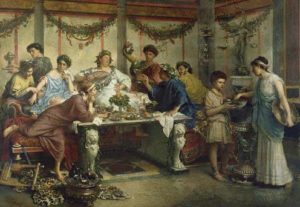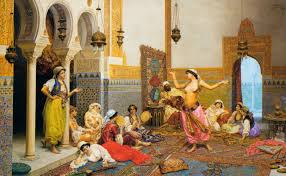Ancient Roman Feasts: The early Roman diet consisted of meat, wild fruits, nuts and some fish. Appetisers would be made up mainly of fruit and nuts and would include, for example, melon drizzled with honey, pear soufflé (made with eggs), seafood cooked with leeks in white wine, and white fish cooked with raisins.
Ancient Roman Feasts
The number of Roman holidays was originally few in number, but some of the oldest and most time-honored survived until the end of the republic, preserving the memory of an ancient agrarian society.

So many festivals were added that the number of festivals eventually outnumbered the number of working days. There was often no distinction between religious and secular activities so that festivals were often events of merrymaking. Originally “feast days,” on holidays the local aristocracy would pay for meals for the poor.
Saturnalia
The Saturnalia (feasts) was held on the 17th December and lasted a full six days. The event seems to date back to the times of king Tullus Hostilius who was the first to make these solemn votive offerings and Roman Feasts in honor of Saturn.

The Saturnalia was a proper feast in every sense. Everybody stopped work, there was a general exchanging of gifts of various sorts and loosening of general rules. For example, it was licit to gamble only during the Saturnalia and at no other time (although this law was respected to different degrees in different epochs of ancient Rome).
Roman banquet entertainment
Roman commoners enjoyed a booming street food scene, the society’s privileged population rallied for rich banquets. Few utilized and benefited from these celebrations quite like Julius Caesar, who was honored as much for his generous, debt-incurring hospitality as he was for sobriety and moderation in an age of gluttony.
Kalends
Kalends was the day to re-kindle the perpetual fire representing the life of Rome at the Temple of the Vestals. Fresh laurels were hung on public buildings. At the same time, it was festival to Mars with dances of the priestly college (Salii) continuing for nineteen days.

The dancers held sacred shields during the ceremony and dined out at a different house each night. These multiple festivals to Mars make sense not just because the month, Martius, was named for him, but also because this was the time of year when the soldiers were called up for the year’s campaigns.
Lucario
Lucario is an ancient Roman feast, solemnized in the woods, where the Romans, defeated and pursued by the Gauls in year 390 BC, retired and concealed themselves; it was held in a wood between the Tyber and the road called Via Salaria.
More info on- ancient Roman parties




